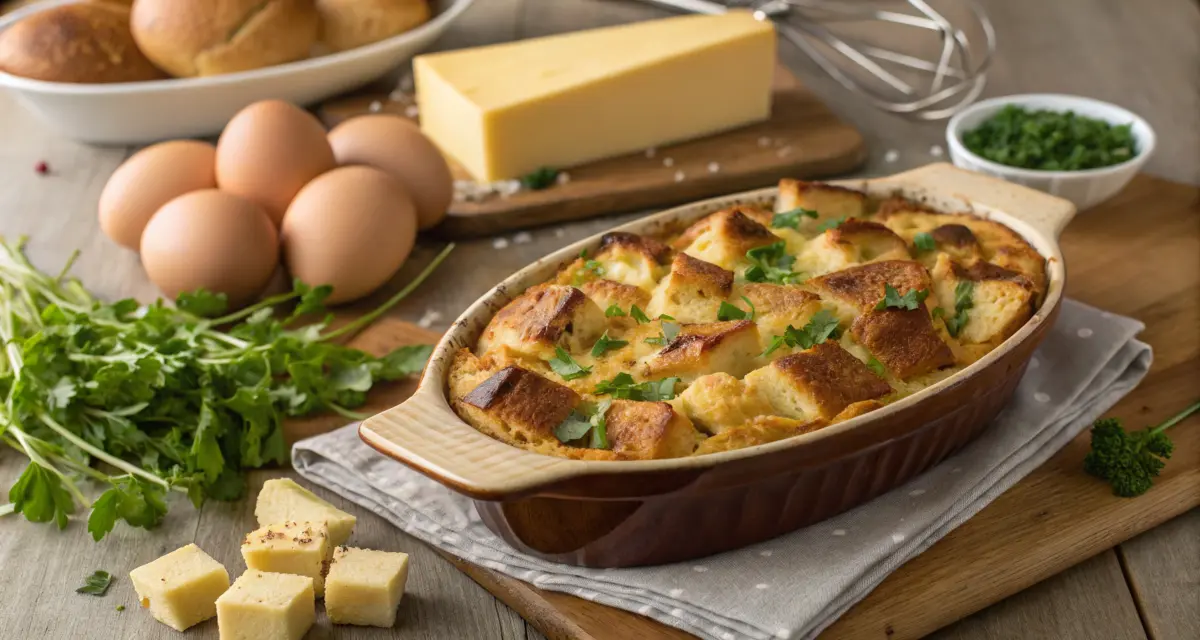
Bread pudding has long been a favorite comfort food, but did you know it can be made savory as well as sweet? This savory bread pudding recipe takes a familiar classic and gives it a flavorful makeover, perfect for any meal of the day. Packed with cheesy goodness, hearty bread, and an array of delicious add-ins, this dish is as versatile as it is satisfying. In this article, you’ll discover the secrets to crafting the perfect savory bread pudding, from choosing the right bread to customizing flavors that suit your palate. Let’s dive in!
Introduction to Savory Bread Pudding
What is Savory Bread Pudding?
Savory bread pudding is a rich, custard-based dish made by soaking chunks of bread in a mixture of eggs and milk or cream, then baking it to perfection. Unlike its sweet counterpart, this version leans into savory flavors like cheese, herbs, and vegetables. Think of it as the love child of a quiche and a casserole, with the bread acting as the star ingredient.
This dish is ideal for repurposing leftover bread into something elegant yet comforting. Whether you’re hosting a brunch, looking for a hearty side, or even crafting a vegetarian main, savory bread pudding has you covered.
A Brief History of Bread Pudding
Bread pudding dates back centuries, originating as a way to avoid wasting stale bread. Over time, it evolved into a culinary staple across cultures, with sweet versions being particularly popular in Europe and America. Savory variations, however, have gained momentum in recent years as people experiment with innovative ways to elevate this humble dish.
Why Opt for Savory Instead of Sweet?
While sweet bread puddings are great for dessert, savory versions bring versatility to the table. They can easily transition from breakfast to dinner and even stand as a main course with the right add-ins. Plus, savory bread pudding recipes provide endless opportunities to mix and match flavors, making them a go-to for adventurous cooks and comfort food lovers alike.
Essential Ingredients for Savory Bread Pudding
The Core: Bread Varieties and Textures
The foundation of any great savory bread pudding recipe lies in the bread you use. Stale or day-old bread works best as it absorbs the custard without becoming mushy. Opt for hearty bread like sourdough, French baguette, ciabatta, or brioche. These types of bread provide structure and enhance the flavor.
For gluten-free options, use gluten-free bread varieties, which are increasingly available in bakeries and stores. Just ensure they’re slightly dried out for better absorption.
Binding Agents: Eggs and Dairy Choices
Eggs and dairy are essential for creating the custard that binds the bread together. Use whole eggs for a rich texture, and don’t skimp on quality. For the dairy, whole milk and heavy cream are traditional choices, but you can mix things up with alternatives like oat milk or almond milk for a lighter dish.
The ratio of eggs to milk is key. Typically, you’ll need about four eggs for every two cups of milk to achieve the right consistency.
Flavor Enhancers: Cheese, Herbs, and Spices
Cheese takes a savory bread pudding from good to extraordinary. Gruyère, cheddar, and Parmesan are excellent options for a bold taste. Herbs like rosemary, thyme, and parsley, along with spices like paprika or nutmeg, add layers of flavor that complement the custard.
If you’re looking for inspiration, King Arthur Baking offers detailed ingredient suggestions for creating the perfect flavor profile.
Optional Add-ins: Vegetables, Meats, and More
The beauty of savory bread pudding is its adaptability. Toss in roasted vegetables, sautéed mushrooms, or cooked meats like bacon or sausage to make it heartier. Seasonal produce such as asparagus or kale can add freshness and color.

Step-by-Step Recipe Guide
Preparation: Choosing and Prepping Bread
Begin by cutting your bread into 1-inch cubes. If your bread isn’t stale, you can lightly toast it in the oven at 300°F for 10–15 minutes to dry it out. This step ensures the bread absorbs the custard evenly.
Place the bread cubes into a greased baking dish, spreading them out to create an even layer. This ensures that every bite will have the perfect balance of bread and filling.
Mixing the Custard Base
In a large mixing bowl, whisk together eggs, milk, cream, and your chosen seasonings. For a standard savory bread pudding recipe, add salt, pepper, and a pinch of nutmeg. If you’re using stronger cheeses or meats, adjust the salt accordingly.
Layering the Ingredients
Add your optional fillings, such as sautéed onions, roasted vegetables, or crumbled sausage, by layering them between the bread cubes. Sprinkle shredded cheese on top for a gooey, melty finish. Pour the custard evenly over the entire dish, pressing the bread down gently to ensure it soaks up the liquid.
For more ideas on ingredient combinations, Serious Eats offers a detailed guide to layering techniques.
Baking to Perfection
Preheat your oven to 350°F. Cover the dish with foil and bake for 30 minutes. Remove the foil and bake for an additional 15–20 minutes, or until the top is golden brown and the custard is set. You’ll know it’s ready when a knife inserted into the center comes out clean.
Let the pudding cool for 5–10 minutes before serving. This step allows the flavors to meld and makes slicing easier. Your savory bread pudding recipe is now ready to enjoy!
Customizing Your Savory Bread Pudding
Regional Variations: French Onion Strata, Croque Monsieur Style, and More
One of the best parts about crafting a savory bread pudding recipe is its versatility. Different regions have their own twists on this comforting dish. French onion strata, for instance, incorporates caramelized onions, Gruyère cheese, and a hint of thyme for a rich, sophisticated flavor. If you’re a fan of French classics, consider trying a Croque Monsieur-inspired bread pudding by layering ham, Dijon mustard, and melted Swiss cheese.
For more unique ideas, check out this Pumpkin Banana Loaf recipe, which highlights how unexpected flavors can transform classic baked dishes.
Dietary Options: Gluten-Free, Vegetarian, and Vegan Alternatives
Whether you’re catering to dietary needs or exploring new options, savory bread pudding can easily be adapted. For a gluten-free version, use gluten-free bread and ensure all other ingredients, like stock or seasonings, are gluten-free certified.
Vegetarians can substitute meat with hearty vegetables like roasted zucchini, bell peppers, or spinach. For a vegan-friendly version, replace eggs with a plant-based substitute (like flax eggs), and use non-dairy milk with nutritional yeast for a cheesy flavor.
Seasonal Twists: Incorporating Fresh Produce
Using seasonal produce not only adds flavor but also makes your dish fresher and more vibrant. Spring vegetables like asparagus and peas work wonderfully, while fall ingredients like butternut squash and sage bring a cozy touch. The possibilities are endless, ensuring your savory bread pudding recipe is always fresh and exciting.
Serving and Pairing Suggestions
Best Ways to Serve Savory Bread Pudding
Savory bread pudding is a fantastic centerpiece or side dish, depending on your meal. Serve it warm from the oven for brunch, paired with a crisp green salad. It’s also great as a holiday side dish, complementing roasted meats or other hearty mains.
For smaller portions, consider baking it in individual ramekins. This makes it perfect for serving at dinner parties or portioning leftovers for lunches.
Pairing with Sides and Beverages
Pair your savory bread pudding with sides that balance its rich flavors. A light arugula salad with a tangy vinaigrette or a bowl of creamy tomato soup can complement the dish beautifully. For beverages, a dry white wine like Sauvignon Blanc or even a light ale can enhance the dish’s savory notes.
For more meal inspiration, check out this Easy Pancake Recipe for a perfect brunch pairing idea.
Creative Leftover Ideas
Leftovers? No problem! Reheat slices for a quick and hearty breakfast, or crumble leftover pudding into scrambled eggs for a delicious twist. You can also freeze portions for up to a month, making it a meal-prep hero.
Troubleshooting and Tips for Success
Common Issues and How to Avoid Them
When making a savory bread pudding recipe, a few common problems can arise, but they’re easy to fix. One frequent issue is soggy pudding. This happens if the custard-to-bread ratio is off or the bread isn’t properly dried. To avoid this, use day-old bread and measure your liquid ingredients carefully.
Another problem is uneven cooking, where the center stays undercooked. Make sure your oven is preheated, and consider using a water bath for consistent heat distribution. If the top browns too quickly, cover the dish with foil during the first half of baking.
Tips for Perfect Texture and Flavor
For the best results, let the bread soak in the custard for 10–15 minutes before baking. This step ensures each piece absorbs maximum flavor. Don’t skimp on seasoning—salt, herbs, and spices are your friends in making the flavors pop.
Cheese is key in a savory bread pudding recipe. Use a combination of melty cheese (like Gruyère) and sharp cheese (like Parmesan) for a dynamic taste. Finally, allow the dish to rest for a few minutes after baking; this helps the pudding set and makes slicing easier.
FAQs about Savory Bread Pudding
Can I Make It Ahead of Time?
Yes! A savory bread pudding recipe is perfect for meal prep. Assemble the dish the night before and refrigerate it, covered. Bake it fresh the next day, adding a few extra minutes to account for the chill.
How Long Does It Last in the Fridge?
Once baked, savory bread pudding can be stored in an airtight container in the fridge for up to 3 days. Reheat in the oven or microwave to bring back its warm, comforting texture.
What Are the Best Breads for This Dish?
Sturdy breads like sourdough, baguette, or brioche work best. Avoid overly soft breads, which can become mushy and lose their structure.
Nutritional Benefits of Savory Bread Pudding
Packed with Protein and Calcium
A savory bread pudding recipe isn’t just delicious it’s also packed with nutritional benefits. Thanks to the eggs and cheese, this dish is a great source of protein, which helps keep you full and energized. Cheese and milk also contribute a healthy dose of calcium, supporting strong bones and teeth.
A Versatile Way to Add Veggies
By including vegetables like spinach, kale, or mushrooms, you can increase the fiber and vitamin content of your bread pudding. Vegetables like bell peppers and zucchini not only add vibrant colors but also boost antioxidants, which are great for overall health.
Customizable for Health Goals
Whether you’re watching calories or trying to up your protein intake, a savory bread pudding recipe can be easily tailored. Swap heavy cream for a lighter milk alternative or use whole-grain bread for added fiber. These small tweaks make it a nutritious option for any meal.
Creative Serving Ideas for Savory Bread Pudding
Elevate Your Presentation
For an elegant touch, serve your savory bread pudding recipe in individual ramekins. This not only makes portion control easy but also adds a sophisticated flair to your meal. Garnish with fresh herbs like parsley or thyme to give it a pop of color and aroma.
Make It a Showstopper at Gatherings
Savory bread pudding is a crowd-pleaser at brunches and potlucks. Serve it alongside crispy bacon, smoked salmon, or a light soup to create a balanced and satisfying spread. For a holiday twist, consider adding cranberries or roasted chestnuts to the pudding for a festive vibe.
Turn Leftovers into a New Meal
Leftover bread pudding doesn’t have to be reheated as is. Slice it into squares, pan-fry until golden, and top with a fried egg for a hearty breakfast. Alternatively, crumble it into a frittata mix or use it as a stuffing substitute in roasted meats.

